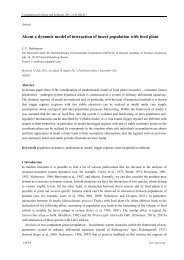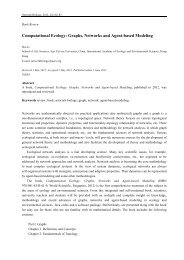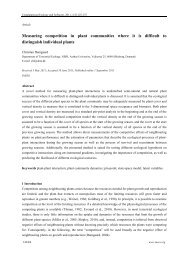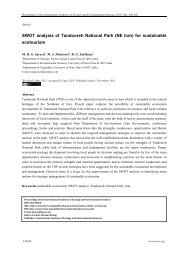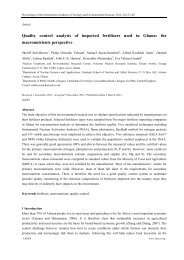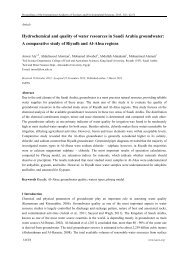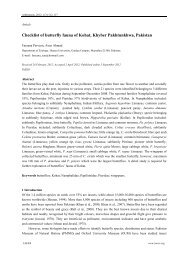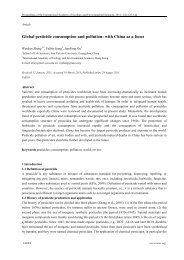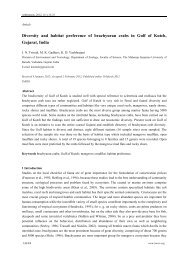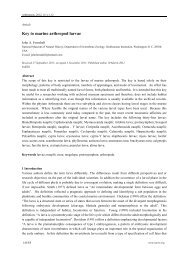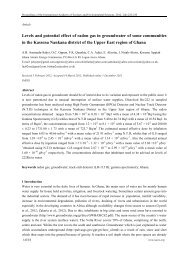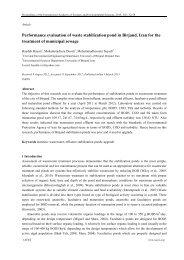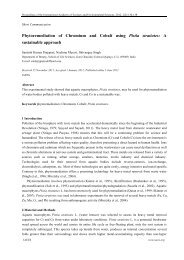Invasion ecology: Origin and biodiversity effects - JournalTOCs
Invasion ecology: Origin and biodiversity effects - JournalTOCs
Invasion ecology: Origin and biodiversity effects - JournalTOCs
Create successful ePaper yourself
Turn your PDF publications into a flip-book with our unique Google optimized e-Paper software.
Environmental Skeptics <strong>and</strong> Critics, 2013, 2(3): 73-81<br />
Article<br />
<strong>Invasion</strong> <strong>ecology</strong>: <strong>Origin</strong> <strong>and</strong> <strong>biodiversity</strong> <strong>effects</strong><br />
John C. Briggs<br />
Department of Fisheries <strong>and</strong> Wildlife, Oregon State University, Corvallis, Oregon 97333, USA<br />
Current address: 2320 Guerneville Rd., CA 95403, USA<br />
E-mail: clingfishes@yahoo.com<br />
Received 18 July 2013; Accepted 28 July 2013; Published online 1 September 2013<br />
Abstract<br />
The history of invasion <strong>ecology</strong>, with respect to its mid-19 th century beginning <strong>and</strong> its extended relationship<br />
with isl<strong>and</strong> biogeography, has not been investigated. In fact, most historical accounts begin with the<br />
publication of Charles Elton’s book in 1958. Since that time, the field has undergone a phenomenal growth<br />
until it has become a major specialty area related to <strong>ecology</strong>, biogeography, <strong>and</strong> macro<strong>ecology</strong>. Over the years,<br />
invasion studies have made significant contributions to knowledge in the areas of colonization, adaptation,<br />
<strong>biodiversity</strong>, evolution, <strong>and</strong> species relationships. But also, many ecologists became convinced that invasive<br />
species were responsible for native extinctions <strong>and</strong> the loss of <strong>biodiversity</strong>. However, new studies, based upon<br />
documented extinctions <strong>and</strong> their causes, have shown that invaders are rarely implicated. Instead, successful<br />
(colonizing) invaders are almost invariably accommodated by the native species that occupy the necessary<br />
habitat. Accommodation results in a gain in species diversity of the invaded area. Diversity gain generally<br />
results in a more stable system with higher productivity <strong>and</strong> a greater resistance to invasion. Furthermore, as<br />
the fossil data indicate, invasions may eventually result in additional speciation that adds to global<br />
<strong>biodiversity</strong>. These data provide evidence of a dynamic, global system consisting of successful invasions that<br />
extend from high species diversity centers outward to where diversity is less <strong>and</strong> the competition weaker.<br />
Keywords accommodation; colonization; competition; facilitation; invasions; invasibility; speciation.<br />
Environmental Skeptics <strong>and</strong> Critics<br />
ISSN 22244263<br />
URL: http://www.iaees.org/publications/journals/environsc/onlineversion.asp<br />
RSS: http://www.iaees.org/publications/journals/environsc/rss.xml<br />
Email: environsc@iaees.org<br />
EditorinChief: WenJun Zhang<br />
Publisher: International Academy of Ecology <strong>and</strong> Environmental Sciences<br />
1 Introduction<br />
Within the past twenty years, the study of invasions by exotic organisms has become so popular that it is now a<br />
major research field within modern <strong>ecology</strong> <strong>and</strong> biogeography. Numerous journals now devote considerable<br />
space to articles on invasive species, two journals are entirely dedicated to the subject, <strong>and</strong> many new books<br />
have appeared. At the same time, some scientists <strong>and</strong> scientific writers have published articles in popular<br />
newspapers <strong>and</strong> magazines dwelling on species extinctions caused by humans <strong>and</strong> human-introduced<br />
organisms. The fact that the great majority of contemporary extinctions have taken place in locations that are<br />
IAEES<br />
www.iaees.org
74<br />
Environmental Skeptics <strong>and</strong> Critics, 2013, 2(3): 73-81<br />
extremely space-limited, such as oceanic isl<strong>and</strong>s or freshwater lakes <strong>and</strong> streams, is often overlooked. As a<br />
result, there has developed among the general public, <strong>and</strong> within some conservation societies, a militaristic<br />
attitude toward invading species. That is, invaders are dangerous <strong>and</strong> must be repelled. As Brown <strong>and</strong> Sax<br />
(2004) have pointed out, invasion <strong>ecology</strong> has a need for more scientific objectivity <strong>and</strong> less emotional<br />
xenophobia.<br />
The earliest work on invasions came with the recognition of long distance dispersal as an important<br />
biological phenomenon. With the exceptions of Darwin <strong>and</strong> Wallace, 19 th century biogeographers, who<br />
divided the earth into a series of regions or provinces, seldom considered that such areas had a dynamic<br />
relationship. The long distance migrations of some birds <strong>and</strong> insects had been recorded but were not judged to<br />
be of general significance. But Darwin (1859) noted that dispersal was a phenomenon of overall importance<br />
<strong>and</strong> thought that animal <strong>and</strong> plant groups were generally younger than the places they inhabited. In this respect,<br />
he differed from the opinions of his friends Joseph Hooker <strong>and</strong> Charles Lyell. Although Darwin emphasized<br />
the importance of dispersal, he also called attention to the influence of barriers to migration which allowed for<br />
the slow process of modification by natural selection.<br />
2 Isl<strong>and</strong> Biogeography<br />
An integral, but often overlooked, part of invasion <strong>ecology</strong> is the knowledge accumulated by 150 years of<br />
isl<strong>and</strong> life studies. With the exception of Ludsin <strong>and</strong> Wolfe (2001), who called attention to Darwin’s<br />
recognition of invasion consequences, accounts of the history of invasion <strong>ecology</strong> almost invariably begin with<br />
the advent of Elton’s (1958) book. A volume entitled Fifty Years of <strong>Invasion</strong> Ecology (Richardson, 2011)<br />
included four chapters that were devoted to historical perspectives, but little reference was made to the<br />
invasion studies that were conducted on isl<strong>and</strong>s from 1858-2011. Early on, biologists began to think of isolated<br />
isl<strong>and</strong>s as microcosms of evolution, dispersal, <strong>and</strong> extinction that could be explored in order to underst<strong>and</strong><br />
such events on a global scale. Darwin <strong>and</strong> Wallace (1858) based their evolution theory on studies of isl<strong>and</strong> life.<br />
Wallace (1880) wrote the first book devoted to isl<strong>and</strong> biogeography. In 1948, K.W. Dammerman published his<br />
famous book on the fauna of Krakatau, illustrating the recolonization of an isl<strong>and</strong> that had been depleted of its<br />
biota.<br />
While studies of isl<strong>and</strong> life have contributed significantly to knowledge about invasions as well as<br />
speciation, acclimatization, evolution, <strong>and</strong> extinction, there has been one unfortunate aspect. As isl<strong>and</strong>s were<br />
occupied by humans <strong>and</strong> the animals they introduced, large numbers of endemic isl<strong>and</strong> species were driven to<br />
extinction (Zhang <strong>and</strong> Chen, 2011). These events, many of which have been highly publicized, gave the<br />
impression that invasions generally produce complete (global) extinctions of native species. Reports of such<br />
extinctions, <strong>and</strong> the subsequent indication that new colonizations on isl<strong>and</strong>s could cause local native losses<br />
(Mac Arthur <strong>and</strong> Wilson, 1967), resulted in a strongly negative attitude toward all invasive species. However,<br />
there is now a new perspective based on the evidence that the great majority of contemporaneous extinctions<br />
were confined to isl<strong>and</strong>s <strong>and</strong> other restricted habitats. For example, bird <strong>and</strong> mammal extinctions recorded for<br />
the past 500 years, indicate that more than 95% took place on isl<strong>and</strong>s (Loehle <strong>and</strong> Eschenbach, 2012). This<br />
suggests that extinction rates on the continents have not been unusually high (three mammals <strong>and</strong> six birds).<br />
3 Other Advances<br />
Charles S. Elton deserves the title “Father of <strong>Invasion</strong> Ecology.” His influential book The Ecology of <strong>Invasion</strong>s<br />
by Animals <strong>and</strong> Plants (1958) established invasion <strong>ecology</strong> as a separate discipline, related to but distinct from<br />
succession <strong>ecology</strong>. This distinction has not been popular among some ecologists who point out that exotic <strong>and</strong><br />
domestic invaders are both colonizers <strong>and</strong> that their <strong>effects</strong> have been fully described in the succession<br />
IAEES<br />
www.iaees.org
Environmental Skeptics <strong>and</strong> Critics, 2013, 2(3): 73-81<br />
75<br />
literature (Davis et al., 2001). By 1958, Elton was already a famous ecologist best known for his books on<br />
animal <strong>ecology</strong> <strong>and</strong> the dynamics of animal populations. So why, in his later years, did Elton suddenly make<br />
the distinction between invasion <strong>and</strong> succession <strong>ecology</strong>? During World War II in Great Britain, Elton was<br />
asked to find better ways to control the rabbits, house mice <strong>and</strong> rats in order to protect the human food supply<br />
(Davis et al., 2001). All of these species were supposed to have originally invaded from Europe <strong>and</strong>, at the<br />
time, the country was under the threat of invasion from Germany. So, in order to emphasize the destruction<br />
caused by those pests, they were called invaders with a militaristic connotation. Elton’s (1958) book focused<br />
almost entirely on notorious invaders of various kinds.<br />
More recently, invasion <strong>ecology</strong> has benefited from advances on other fronts. Williamson (1996) published<br />
a textbook on biological invasions intended for both students <strong>and</strong> professionals. This work covers the main<br />
aspects of the subject with appropriate examples. The emphasis is on invaders as pest species, but this simply<br />
reflects the majority of published literature. Another major publication is the book Species <strong>Invasion</strong>s (Sax et al.,<br />
2005). More recently, several other books dealing primarily with invasions, have been published. A review of<br />
ecological <strong>and</strong> evolutionary insights provided by invasions has been published (Sax et al., 2007). All of these<br />
books <strong>and</strong> the indicated review represent a small part of the enormous increase in publications on invasion<br />
biology that has taken place within the past 20 years. In retrospect, our present knowledge about species<br />
invasions represents an accumulation from continued isl<strong>and</strong> studies <strong>and</strong> the post-1958 revival of interest in the<br />
subject.<br />
Along with the general increase of interest in invasions, marine invasive organisms became an important<br />
research focus, <strong>and</strong> a noticeable dichotomy developed between the fields of marine <strong>and</strong> terrestrial invasion<br />
<strong>ecology</strong>. Most of the early marine work was concerned with the damage inflicted by pest species introduced by<br />
ships into harbors <strong>and</strong> estuaries (Briggs, 2012). Despite the fact that modern invasion research in both<br />
environments has become devoted to much the same questions (influences of species diversity, disturbance,<br />
vectors, propagule pressure, competition, etc.), the results tend to be reported in different journals with very<br />
little cross-referencing. Therefore, it has become important to examine both fields to see if advances in one<br />
might be applicable to the other.<br />
4 Marine <strong>Invasion</strong>s<br />
Some ecologists have identified exotic invaders as major threats to marine <strong>biodiversity</strong> despite scant evidence<br />
that <strong>biodiversity</strong> (here meaning species diversity or richness) is really being decreased. Molnar et al. (2008)<br />
used the Pacific oyster, Crassostrea gigas, as a prime example of a threat species. But this bivalve, although<br />
undesired in some places, cannot be conceived of as a threat to <strong>biodiversity</strong>. In northern Patagonia, it increased<br />
the population densities of epifaunal <strong>and</strong> infaunal organisms <strong>and</strong> also the feeding rates of bird species (Escapa<br />
et al., 2004). In the Wadden Sea, Crassostrea has partially replaced the native Mytilus <strong>and</strong> the community<br />
associated with the oysters showed superior species richness, abundance, <strong>and</strong> biomass (Reise et al., 2005). The<br />
Pacific oyster is an engineer species that enhances species diversity rather than being a threat, <strong>and</strong> there are<br />
other invader species that belong in the same category (Schlaepfer et al., 2011).<br />
The majority of successful marine invasions, known to involve reactions by native species, appear to<br />
consist mainly of alterations in abundance or shifts in habitat (Briggs, 2010). The latter is sometimes described<br />
as niche sharing or niche compression. But in most cases, it is not clear that niche alteration is involved. As<br />
will be noted in this paper, several terms describing the relationships between invaders <strong>and</strong> native species have<br />
been proposed. Most of the interspecies reactions have been reported by observers from the Mediterranean or<br />
the Wadden Sea. Although hundreds of marine invasions have been reported worldwide, mainly from harbors<br />
or estuaries, the details of the process by which invaders are accepted into native ecosystems remain<br />
IAEES<br />
www.iaees.org
76<br />
Environmental Skeptics <strong>and</strong> Critics, 2013, 2(3): 73-81<br />
undescribed or poorly understood. The lack is probably due to the difficulties of long-term observation in the<br />
marine environment. Competition resulting from marine invasions has been demonstrated but competitive<br />
exclusion is rare (Byers, 2009).<br />
Observations from Eastern Mediterranean invasions (Galil, 2007) <strong>and</strong> invasions in the Wadden Sea (Reise,<br />
2005), as well as conclusions from widespread regional vs. local data (Witman et al., 2004, Karlson et al.,<br />
2004), indicate that invasions take place almost entirely from areas of high species diversity to low diversity<br />
areas. But, even the richest communities are occasionally invasible (Briggs <strong>and</strong> Bowen, 2013). The most<br />
diverse (species rich) biotas are those in which the st<strong>and</strong>ards of competitive performance are highest (Vermeij,<br />
2005). Therefore, competition can be viewed as an integral component of the colonization process, i.e., species<br />
from high species diversity areas appear to have the advantage. But the natives almost always manage to retain<br />
part of their original habitat. The common occurrence of acceptance by native species explains why invaders<br />
from high diversity hot spots can spread their influence over vast geographic areas.<br />
There has been some criticism that contemporary acceptance of invaders may not be long-lasting <strong>and</strong> that<br />
future years might bring extinctions <strong>and</strong> loss of <strong>biodiversity</strong> (Ricciardi <strong>and</strong> Simberloff, 2009). In response, one<br />
can point to historic events where the consequences of large-scale invasions have been documented.<br />
Information from several historic invasions (Vermeij, 1991, 2005; Patzkowsky <strong>and</strong> Holl<strong>and</strong>, 2007) showed<br />
that, once invaders became established, the relationships with the natives commonly lasted one million to<br />
several million years. Furthermore, the fossil evidence indicated that millions of years after an invasion, large<br />
numbers of the invaders had undergone speciation, thus adding to global <strong>biodiversity</strong>. Other workers found,<br />
in the Devonian Period, a long-term diversity decline due to the preferential survival of the invaders together<br />
with a depression of speciation rate (Stigall <strong>and</strong> Lieberman, 2006), but this was evidently not true for the<br />
Neogene when speciation rates were not depressed. An Ordovician study found evidence of a global richness<br />
equilibrium dictated by a combination of invasion (migration), origination, <strong>and</strong> extinction rates (Heim, 2008).<br />
Information combined from various historical <strong>and</strong> recent invasions led to the proposal of a three step process:<br />
invasion to accommodation to speciation (IAS). This process, called the IAS mechanism (Briggs, 2010), has<br />
apparently contributed to historical increases in global marine species diversity.<br />
5 Terrestrial <strong>Invasion</strong>s<br />
Freshwater streams <strong>and</strong> lakes, even though they may be considered part of the general terrestrial l<strong>and</strong>scape,<br />
exhibit an extensive history of invasion by exotic organisms. In comparison to most continental <strong>and</strong> marine<br />
habitats, freshwater aquatic habitats are extremely space-limited. This means that freshwater invasions <strong>and</strong><br />
overfishing have resulted in numerous extinctions <strong>and</strong> ecosystem alterations (Ricciardi <strong>and</strong> MacIsaac, 2011),<br />
so the results are quite similar to those that have been discovered for oceanic isl<strong>and</strong>s. In general, as Strayer<br />
(2010) has pointed out in his review, classes of ecologically important invaders include molluscs that are<br />
primary consumers, fishes that affect the food web from its apex or center, decapods that are powerful<br />
omnivores, plants that have strong engineering <strong>and</strong> primary production <strong>effects</strong>, <strong>and</strong> diseases that can affect<br />
humans as well as other organisms.<br />
Plant invasion <strong>ecology</strong> has been investigated more thoroughly <strong>and</strong> by more scientists than invasions of<br />
other organisms. The term “invasibility” has been used to describe the susceptibility of communities to exotic<br />
species (Lonsdale, 1999). The idea of invasibility stems from the biotic resistance hypothesis of Elton (1958)<br />
who suggested a negative relationship between native species diversity <strong>and</strong> invasion success. This is often true<br />
but resistance to invasion (biotic resistance) can vary depending on the amount of open space that is available<br />
(Stachowicz <strong>and</strong> Byrnes, 2006). Richardson <strong>and</strong> Pysek (2006) pointed out that factors other than species<br />
diversity must be important, <strong>and</strong> identified four that have been particularly influential: (1) disturbance, (2)<br />
IAEES<br />
www.iaees.org
Environmental Skeptics <strong>and</strong> Critics, 2013, 2(3): 73-81<br />
77<br />
competitive release, (3) resource availability, <strong>and</strong> (4) propagule pressure. But also widely recognized is the<br />
“fluctuating resource theory of invasibility” (Davis et al., 2000).<br />
Another term, also primarily devoted to plant invasions but with some marine animal examples, is<br />
“facilitation “(Stachowicz, 2001; Bruno et al., 2003). Facilitation has been defined as direct positive<br />
interactions between two organisms that benefit at least one. This definition includes commensalisms <strong>and</strong><br />
mutualisms as well as mutually obligate <strong>and</strong> facultative relationships. In plant communities, facilitation may<br />
alternate with competition in response to environmental change (Callaway <strong>and</strong> Walker, 1997). A review of the<br />
literature on biotic interactions (Bruno et al., 2005) suggested that direct facilitative interactions are at least as<br />
common <strong>and</strong> as important as competition <strong>and</strong> predation in structuring communities. Richardson et al. (2000)<br />
argued that a key lesson in invasion <strong>ecology</strong> was that facilitation by numerous resident species was often<br />
required for successful colonization. But some authors (Munguia et al., 2009) believe that facilitation is not a<br />
true species interaction because the fitness of one of the species involved remains unaffected.<br />
The term “accommodation” was initially proposed to characterize colonizing invasions in the marine<br />
environment (Briggs, 2010). Accommodation means the yielding of living space, indicating that whatever<br />
native species occupies the preferred space, it will give way to or support the invader permitting both species<br />
to become established in a location where only one existed previously. Compared to facilitation,<br />
accommodation is the broader term because it includes facilitation, as well the competition that is perceived<br />
when the native species is apparently forced to give way to or physically support the intruder. So, successful<br />
invasions can be said to be driven by dispersal (human or natural), discovery of suitable locations, <strong>and</strong><br />
accommodation by native organisms. Sometimes, the critical factor may be substrate suitability (invasibility)<br />
or facilitation, but when the details of the species relationships are unknown, as is often the case,<br />
accommodation (as the more inclusive term) may be employed. Finally, it may be noted that both invader<br />
species <strong>and</strong> exp<strong>and</strong>ing native species are accommodated when they move into new ecosystems, but no<br />
differences in acceptance between the two have been reported.<br />
Another factor, also first noted in regard to the marine environment, was the existence of fossil data<br />
indicating that historical invasions had resulted in significant increases in speciation over millions of years.<br />
Thus at least some of the local diversity increases produced by the invasions were eventually converted into<br />
global increases. Similar information is available in regard to historical plant invasions. The classic paper by<br />
Lidgard <strong>and</strong> Crane (1990) <strong>and</strong> a more recent study by Magallon <strong>and</strong> Castillo (2009) traced the rise in<br />
angiosperm species diversity through the Cretaceous. Angiosperm plants first appeared in equatorial regions<br />
about 140 million years ago (Ma). About 90 Ma, angiosperms invaded the higher latitudes <strong>and</strong> gradually<br />
became the dominant type of vegetation while the cycads, ferns, <strong>and</strong> conifers declined. The enormous gains in<br />
angiosperm species diversity that took place following their high latitude dispersal, indicated that their<br />
invasions had lasting benefits in terms of an increases in global <strong>biodiversity</strong>.<br />
6 Extinctions<br />
Aside from cases on oceanic isl<strong>and</strong>s, freshwater lakes <strong>and</strong> streams, <strong>and</strong> other similarly restricted habitats, there<br />
appears to be a virtual absence of invasion caused extinctions (Gurevitch <strong>and</strong> Padilla, 2004). In cases involving<br />
marine organisms, l<strong>and</strong> plants, <strong>and</strong> smaller terrestrial animals, evidence for invasion caused extinctions is<br />
weak or nonexistent, except on isl<strong>and</strong>s (Vermeij, 2005). There is no evidence that competition from exotic<br />
plants has caused any native species extinctions (Davis, 2003) <strong>and</strong>, even on isl<strong>and</strong>s, plant <strong>and</strong> animal<br />
extinctions are primarily caused by predation rather than competition (Sax <strong>and</strong> Gaines, 2008). In the marine<br />
environment there have been no cases of native extinction resulting from competition by exotic species (Sagoff,<br />
2005; Briggs, 2007, 2012). In fact, there have been very few contemporary, marine extinctions from any cause.<br />
IAEES<br />
www.iaees.org
78<br />
Environmental Skeptics <strong>and</strong> Critics, 2013, 2(3): 73-81<br />
But during the past 50 years, government supported, commercial fishing has resulted in the collapse of about a<br />
thous<strong>and</strong> populations that once supplied most of the world’s seafood. For the collapsed species, now existing<br />
as small remnants of their former population sizes, the future is bleak. They suffer from the loss of genetic<br />
diversity, inbreeding depression, <strong>and</strong> depensation (Allee effect). Because marine species were eliminated by<br />
historic climatic changes, continued global warming is likely to result in the extinction of small populations<br />
that already have a precarious existence. They may be considered evidence of an extinction debt that must be<br />
paid as the climate change becomes more severe (Briggs, 2011). Small terrestrial populations await a similar<br />
fate.<br />
7 A Dynamic World<br />
For both l<strong>and</strong> <strong>and</strong> sea, it has become apparent that exotic species, which succeed in colonizing a native<br />
ecosystem, rarely cause extinctions <strong>and</strong> are instead accommodated by the native species that occupy the<br />
appropriate niches or habitats. The accommodation process results in a gain in the species diversity of the<br />
invaded area. Furthermore, as the fossil data indicate, invasions may eventually result in additional speciation<br />
that adds to global diversity. In terrestrial systems, diversity gain generally results in a more stable system with<br />
higher productivity <strong>and</strong> a greater resistance to invasion (Tilman et al., 1996; Lehman <strong>and</strong> Tilman, 2000;<br />
Stachowicz <strong>and</strong> Tilman, 2005). This is true in the marine environment as well (Vermeij, 2005; Worm et al.,<br />
2006). Among ecologists, there is a broad consensus that a positive relationship exists between species<br />
diversity <strong>and</strong> ecosystem stability (Hooper et al., 2005). <strong>Invasion</strong>s have been observed in almost all parts of the<br />
world <strong>and</strong> increases in diversity may continue to build up until the next drastic climate change, which may<br />
already be on the way. In the sea, there is a global dispersal system consisting of successful invasions that<br />
branch from high species diversity centers outward to where diversity is less <strong>and</strong> the competition weaker<br />
(Briggs <strong>and</strong> Bowen, 2013); <strong>and</strong> diversity in peripheral ecosystems is apparently dependent on a continuous<br />
flow of species from regional sources (Karlson et al., 2004). <strong>Invasion</strong> may be as crucial to the long-term<br />
development <strong>and</strong> vigor of communities <strong>and</strong> ecosystems as mutation is to the long-term evolution of<br />
populations <strong>and</strong> species (Vermeij, 2005).<br />
8 Conclusions<br />
Although invasion <strong>ecology</strong> had its origin in the mid-19th century when the importance of species dispersal<br />
became apparent, <strong>and</strong> made significant progress during the ensuing 150 years of isl<strong>and</strong> studies, it did not<br />
become recognized as a separate discipline until the appearance of the 1958 book by Charles Elton. Over the<br />
years, invasion studies have contributed greatly to the general areas of <strong>ecology</strong>, colonization, adaptation,<br />
evolution, <strong>and</strong> species diversity. On l<strong>and</strong> <strong>and</strong> in the sea, invader species add to local diversity. The mechanism<br />
that allows this to happen has been called invasibility or facilitation or accommodation. In the sea, it seems<br />
that the addition process must have a competitive component because successful (colonizing) invasions take<br />
place almost entirely from areas of high species diversity areas to those of lesser diversity. On l<strong>and</strong>,<br />
competition is also important because various kinds of plant competition have been described, but the<br />
relationship between regional <strong>and</strong> local species diversity is not quite as clear. In both environments, exotic<br />
invaders were noted to cause species diversity increases in local communities. Facilitation is widespread but<br />
may not occur in most cases of successful invasion. The term “accommodation” includes facilitation, niche<br />
sharing, niche compression, <strong>and</strong> mutualism; thus, it is applicable to almost all invasions that result in<br />
colonizations.<br />
In the sea, paleontological studies have shown that accommodation leads to long-term relationships<br />
between invader <strong>and</strong> native species <strong>and</strong>, in the long-term, speciation produces increases in global species<br />
IAEES<br />
www.iaees.org
Environmental Skeptics <strong>and</strong> Critics, 2013, 2(3): 73-81<br />
79<br />
diversity. On l<strong>and</strong>, the greatest change in plant diversity took place beginning with the evolution of the<br />
angiosperm flora about 140 Ma. As the angiosperms invaded the higher latitudes, they underwent an enormous<br />
increase in species diversity. This suggests that the causes <strong>and</strong> ultimate <strong>effects</strong> of historic invasions may be<br />
quite similar in both terrestrial <strong>and</strong> marine environments, <strong>and</strong> that the invasion to accommodation to speciation<br />
(IAS) process may be applicable to each. It may be observed that, while marine <strong>and</strong> terrestrial <strong>ecology</strong> remain<br />
separate disciplines, there is a pervasive similarity in regard to invasive species. The result of almost all<br />
contemporary (colonizing) invasions is accommodation, not elimination. The natural world of invasion <strong>and</strong><br />
native reaction is more in keeping with the admonition “love thy neighbor” instead of “man the ramparts.”<br />
Acknowledgements<br />
I wish to thank D. F. Sax <strong>and</strong> E.A. Hanni for pointing out omissions <strong>and</strong> suggesting additions that improved<br />
the manuscript.<br />
References<br />
Briggs JC. 2007. Marine biogeography <strong>and</strong> <strong>ecology</strong>: invasions <strong>and</strong> introductions. Journal of Biogeography, 34:<br />
193-198<br />
Briggs JC. 2010. Marine biology: the role of accommodation in shaping marine <strong>biodiversity</strong>. Marine Biology,<br />
157: 2117-2126<br />
Briggs JC. 2011. Marine extinctions <strong>and</strong> conservation. Marine Biology, 158: 485-488<br />
Briggs JC. 2012. Marine species invasions in estuaries <strong>and</strong> harbors. Marine Ecology Progress Series, 449: 297-<br />
302<br />
Briggs JC, Bowen BW. 2013. Marine shelf habitat: biogeography <strong>and</strong> evolution. Journal of Biogeography.<br />
doi:10.1111/jbi.12082<br />
Brown JH, Sax DF. 2004. An essay on some topics concerning invasive species. Austral Ecology, 29: 530-536<br />
Bruno JF, Stachowicz JJ, Bertness MD. 2003. Inclusion of facilitation into ecological theory. Trends in<br />
Ecology <strong>and</strong> Evolution, 18: 119-125<br />
Bruno JF, Fridley JD, Bromberg K, Bertness MD. 2005. Insights into biotic interactions from studies of<br />
species invasions. In: Species <strong>Invasion</strong>s (Sax DF, Stachowicz JJ, Gaines SD, eds). 13-40, Sinauer,<br />
Sunderl<strong>and</strong>, MA, USA<br />
Byers JE. 2009. Competition in marine invasions. In: Biological <strong>Invasion</strong>s in Marine Ecosystems (Rilov G,<br />
Crooks JA, eds). 245-260, Springer, New York, USA<br />
Callaway RM, Walker LR. 1997. Competition <strong>and</strong> facilitation: a synthetic approach to interactions in plant<br />
communities. Ecology, 78: 1958-1965<br />
Dammerman KW. 1948. The fauna of Krakatau, 1883-1933. Proceedings of the Royal Academy of Sciences,<br />
Amsterdam, 44: 1-594<br />
Darwin C. 1859. On the <strong>Origin</strong> of Species by Means of Natural Selection, or the Preservation of Favoured<br />
Races in the Struggle for Life. John Murray, London, UK<br />
Darwin C, Wallace AR. 1858. On the tendency of species to form varieties; <strong>and</strong> on the perpetuation of<br />
varieties <strong>and</strong> species by means of natural selection. Proceedings of the Linnean Society of London,<br />
Zoology, 3: 46-50<br />
Davis MA. 2003. Biotic globalization: does competition from introduced species threaten global <strong>biodiversity</strong>?<br />
BioScience, 53: 481-489<br />
Davis MA, Grime JP, Thompson K. 2000. Fluctuating resources in plant communities: a general theory of<br />
IAEES<br />
www.iaees.org
80<br />
Environmental Skeptics <strong>and</strong> Critics, 2013, 2(3): 73-81<br />
invasibility. Journal of Ecology, 88: 528-534<br />
Davis MA, Thompson K, Grime JP. 2001. Charles S. Elton <strong>and</strong> the dissociation of invasion <strong>ecology</strong> from the<br />
rest of <strong>ecology</strong>. Diversity <strong>and</strong> Distributions, 7: 97-102<br />
Elton CS. 1958. The Ecology of <strong>Invasion</strong>s by Animals <strong>and</strong> Plants. Methuen, London, UK<br />
Escapa M, Isacch JP, Daleo P. et al. 2004. The distribution <strong>and</strong> ecological <strong>effects</strong> of the introduced Pacific<br />
oyster Crassostrea gigas (Thunberg, 1793) in northern Patagonia. Journal of Shellfish Research, 23: 765-<br />
772<br />
Galil BS. 2007. Loss or gain? Invasive aliens <strong>and</strong> <strong>biodiversity</strong> in the Mediterranean Sea. Marine Pollution<br />
Bulletin, 55: 314-322<br />
Gurevitch J, Padilla DK. 2004. Are invasive species a major cause of extinctions? Trends in Ecology <strong>and</strong><br />
Evolution, 19: 470-474<br />
Heim NA. 2008. A null biogeographic model for quantifying the role of migration in shaping patterns of<br />
global taxonomic richness <strong>and</strong> differentiation diversity, with implications for Ordovician biogeography.<br />
Paleobiology, 34: 195-209<br />
Hooper DU, Chapin FS, Ewel JJ. et al. 2005. Effects of <strong>biodiversity</strong> on ecosystem functioning: a consensus of<br />
current knowledge. Ecological Monographs, 75: 3-35<br />
Karlson RH, Cornell HV, Hughes TP. 2004. Coral communities are regionally enriched along an oceanic<br />
<strong>biodiversity</strong> gradient. Nature, 429: 867-870<br />
Lehman CL, Tilman D. 2000. Biodiversity, stability <strong>and</strong> productivity in competitive communities. American<br />
Naturalist, 156: 534-552<br />
Lidgard S, Crane PR. 1990. Angiosperm diversification <strong>and</strong> Cretaceous floristic trends; a comparison of<br />
palynofloras <strong>and</strong> leaf macrofloras. Paleobiology, 16: 77-93<br />
Lonsdale WM. 1999. Global patterns of plant invasions <strong>and</strong> the concept of invasibility. Ecology, 80: 1522-<br />
1536<br />
Loehle C, Eschenbach W. 2012. Historic bird <strong>and</strong> terrestrial mammal extinction: rates <strong>and</strong> causes. Diversity<br />
<strong>and</strong> Distributions, 18: 84-91<br />
Ludsin SA, Wolfe AD. 2001. Biological invasion theory: Darwin’s contributions from The <strong>Origin</strong> of Species.<br />
BioScience, 15: 780-789<br />
MacArthur RH, Wilson EO. 1967. The Theory of Isl<strong>and</strong> Biogeography. Princeton University Press, Princeton,<br />
NJ, USA<br />
Magallo S, Castillo A. 2009. Angiosperm diversification through time. American Journal of Botany, 96: 349-<br />
365<br />
Molnar JL, Gamboa RL, Revenga C, Spalding F. 2008. Assessing the global threat of invasive species to<br />
marine <strong>biodiversity</strong>. Frontiers of Ecological Environment, 6: 485-492<br />
Munguia P, Ojanguren AF, Evans AN. et al. 2009. Is facilitation a true species interaction? Open Ecology<br />
Journal, 2: 83-85<br />
Patzkowsky ME, Holl<strong>and</strong> SM. 2007. Diversity partitioning of a late Ordovician marine biotic invasion:<br />
controls on diversity in regional ecosystems. Paleobiology, 33: 295-309<br />
Reise K, Dankers N, Essink K. 2005. Introduced species, Wadden Sea quality status 2004, Trilateral<br />
Monitoring Report <strong>and</strong> Assessment Group. Wadden Sea Ecology System, 19: 155-161<br />
Ricciardi A, Simberloff D. 2009. Assisted colonization is not a viable conservation strategy. Trends in Ecology<br />
<strong>and</strong> Evolution, 24: 248-253<br />
Ricciardi A, MacIsaac HJ. 2011. Impacts of biological invasions on freshwater ecosystems. In: Fifty Years of<br />
<strong>Invasion</strong> Ecology (Richardson DM, ed). 211-224, Wiley-Blackwell, Oxford, UK<br />
IAEES<br />
www.iaees.org
Environmental Skeptics <strong>and</strong> Critics, 2013, 2(3): 73-81<br />
81<br />
Richardson DM, Allsopp N, D’Antonio CM, et al. 2000. Plant invasions-the role of mutualisms. Biological<br />
Reviews, 75: 65-93<br />
Richardson DM, Pysek P. 2006. Plant invasions: merging the concept of species invasiveness <strong>and</strong> community<br />
invasibility. Progress in Physical Geography, 30: 409-431<br />
Richardson DM. 2011. Fifty Years of <strong>Invasion</strong> Ecology. Wiley-Blackwell, Oxford, UK<br />
Sagoff M. 2005. Do non-native species threaten the natural environment? Journal of Agricultural<br />
Environmental Ethics, 5: 52-54<br />
Sax DF, Stachowicz JJ, Gaines SD. 2005. Species <strong>Invasion</strong>s. Sinauer, Sunderl<strong>and</strong>, MA, USA<br />
Sax DF, Stachowicz JJ, Brown, JH. et al. 2007. Ecological <strong>and</strong> evolutionary insights from species invasions.<br />
Trends in Ecology <strong>and</strong> Evolution, 22: 465-471<br />
Sax DF, Gaines SD. 2008. Species invasions <strong>and</strong> extinction: the future of native <strong>biodiversity</strong> on isl<strong>and</strong>s.<br />
Proceedings of the National Academy of Sciences of USA, 105: 11490-11497<br />
Schlaepfer MA, Sax DF, Olden JD. 2011. The potential conservation value of non-native species.<br />
Conservation Biology, 25: 428-437<br />
Stachowicz JJ. 2001. Mutualism, facilitation, <strong>and</strong> the structure of ecological communities. BioScience, 51:<br />
235-246<br />
Stachowicz JJ, Tilman D. 2005. Species invasions <strong>and</strong> the relationships between species diversity, community<br />
saturation, <strong>and</strong> ecosystem functioning. In: Species <strong>Invasion</strong>s (Sax DF, Stachowicz JJ, Gaines SD, eds). 41-<br />
64, Sinauer, Sunderl<strong>and</strong>, MA, USA<br />
Stachowicz JJ, Byrnes JE. 2006. Species diversity, invasion success, <strong>and</strong> ecosystem functioning: disentangling<br />
the influence of resource competition, facilitation, <strong>and</strong> extrinsic factors. Marine Ecology Progress Series,<br />
311: 251-262<br />
Stigall AL, Lieberman BS. 2006. Quantitative paleobiogeography: GIS, phylogenetic biogeographical analysis,<br />
<strong>and</strong> conservation insights. Journal of Biogeography, 33: 2051-2060<br />
Strayer DL. 2010. Alien species in fresh waters: ecological <strong>effects</strong>, interactions with other stressors, <strong>and</strong><br />
prospects for the future. Freshwater Biology, 55(Supplement s1): 152-174<br />
Tilman D. 1996. Biodiversity: population vs. ecosystem stability. Ecology, 77: 350-363<br />
Vermeij GJ. 1991. When biotas meet: underst<strong>and</strong>ing biotic interchange. Science, 253: 1099-1104<br />
Vermeij GJ. 2005. <strong>Invasion</strong> as expectation. In: Species <strong>Invasion</strong>s (Sax DF, Stachowicz JJ, Gaines SD, eds).<br />
315-339, Sinauer, Sunderl<strong>and</strong>, MA, USA<br />
Wallace AR. 1880. Isl<strong>and</strong> Life. Macmillan, London, UK<br />
Williamson M. 1996. Biological <strong>Invasion</strong>s. Chapman <strong>and</strong> Hall, London, UK<br />
Witman JD, Etter RL, Smith F. 2004. The relationship between regional <strong>and</strong> local species diversity in marine<br />
benthic communities. Proceedings of the National Academy of Sciences of USA, 101: 15664-15669<br />
Worm B, Barbier EB, Beaumont N, et al. 2006. Impacts of <strong>biodiversity</strong> loss on ocean ecosystem services.<br />
Science, 314: 787-790<br />
Zhang WJ, Chen B. 2011. Environment patterns <strong>and</strong> influential factors of biological invasions: a worldwide<br />
survey. Proceedings of the International Academy of Ecology <strong>and</strong> Environmental Sciences, 1(1): 1-14<br />
IAEES<br />
www.iaees.org



